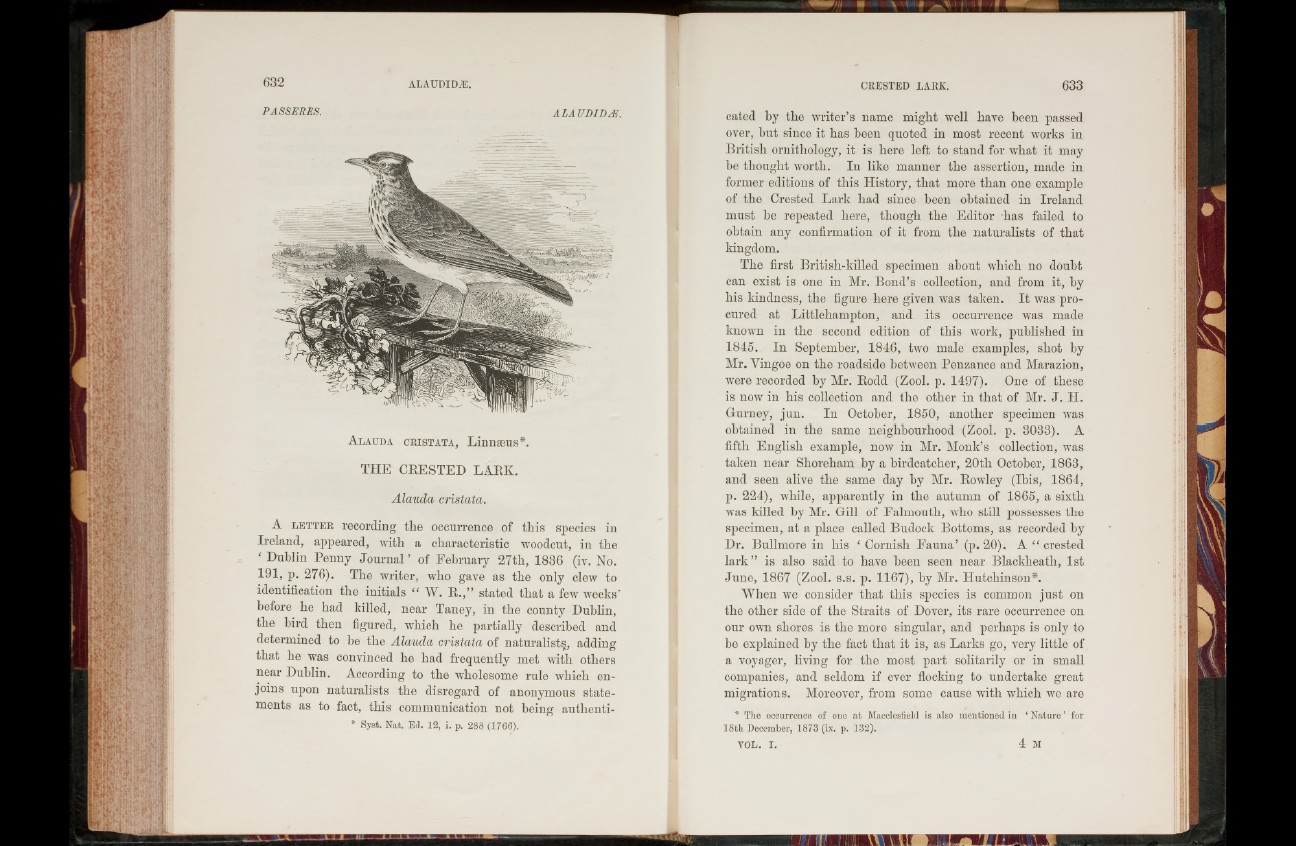
A la u d a c b is t a t a , Linnseus*.
THE CRESTED LARK.
Alauda cristata.
A l e t t e r recording the occurrence of this species in
Ireland, appeared, with a characteristic woodcut, in the
‘ Dublin Penny Journal ’ of February 27th, 1836 (iv. No.
191, p. 276). The writer, who gave as the only clew to
identification the initials “ W. R .,” stated that a few7 weeks'
before he had killed, near Taney, in the county Dublin,
the bird then figured, which he partially described and
determined to he the Alauda cristata of naturalist^, adding
that he was convinced he had frequently met with others
near Dublin. According to the wholesome rule which enjoins
upon naturalists the disregard of anonymous statements
as to fact, this communication not being authenti-
* Syst. Nat. Ed. 12, i. p. 288 (1766).
cated by the writer’s name might well have been passed
over, but since it has been quoted in most recent works in
British ornithology, it is here left to stand for what it may
he thought worth. In like manner the assertion, made in
former editions of this History, that more than one example
of the Crested Lark had since been obtained in Ireland
must he repeated here, though the Editor has failed to
obtain any confirmation of it from the naturalists of that
kingdom.
The first British-killed specimen about which no doubt
can exist is one in Mr. Bond’s collection, and from it, by
his kindness, the figure here given was taken. I t was procured
at Littleliampton, and its occurrence was made
known in the second edition of this work, published in
1845. In September, 1846, two male examples, shot by
Mr. Yingoe on the roadside between Penzance and Marazion,
were recorded by Mr. Rodd (Zool. p. 1497). One of these
is now in his collection and the other in that of Mr. J . H.
Gurney, jun. In October, 1850, another specimen was
obtained in the same neighbourhood (Zool. p. 3033). A
fifth English example, now in Mr. Monk’s collection, was
taken near Slioreham by a birdcatcher, 20tli October, 1863,
and seen alive the same day by Mr. Rowley (Ibis, 1864,
p. 224), while, apparently in the autumn of 1865, a sixth
was killed by Mr. Gill of Falmouth, who still possesses the
specimen, at a place called Budock Bottoms, as recorded by
Dr. Bullmore in his ‘ Cornish Fauna’ (p. 20). A “ crested
la rk ” is also said to have been seen near Blacklieath, 1st
June, 1867 (Zool. s.s. p. 1167), by Mr. Hutchinson*.
When we consider that this species is common just on
the other side of the Straits of Dover, its rare occurrence on
our own shores is the more singular, and perhaps is only to
he explained by the fact that it is, as Larks go, very little of
a voyager, living for the most part solitarily or in small
companies, and seldom if ever flocking to undertake great
migrations. Moreover, from some cause with which we are
* The occurrence of one at Macclesfield is also mentioned in ‘ Nature * for
18th December, 1873 (ix. p. 132).
VOL. I. 4 M